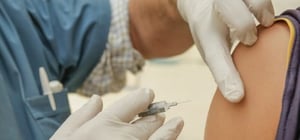Genedrive (LON:GDR) is the topic of conversation when Hardman and Co’s Analyst Dr Dorothea Hill caught up with DirectorsTalk for an exclusive interview.
Q1: You recently released a note explaining that you are anticipating accelerated news flow from Genedrive. Can you give us an update on what has been going on at Genedrive?
Yes, of course. The note thatwe published earlier this week draws attention to what we believe is a new phase for Genedrive, whereby the growth strategy that it has been implementing over the past couple of years is going to start to yield a greater flow of announcements – and we think this is a really positive transition, because, very simply, it will give the market more visibility on the company’s progress
Q2: So, what kind of updates will you be looking for?
Primarily, we are expecting scientific and regulatory news.
So, to take a step back, the company is aiming to achieve significant revenues from three of its assays by 2022 – from its NHS screening test, its diagnostic for tuberculosis infection, and its hepatitis C test, which is already fully regulated and on the market.
Towards achieving this 2022 goal, a lot of progress has been made under the radar in commercialising the hepatitis C assay and in progressing the clinical studies of the NHS screening test. For instance, in terms of the HCV assay, the company has had to perform no fewer than six individual studies tailored to particular countries since it was first launched. And, as a result, in the next 12 months or so we, will be looking for additional scientific data from these studies and news on new registrations of the HCV test. There may also be news on commercial partnerships.
Q3: What do investors need to understand when evaluating diagnostics?
Well, we’ve put the detail in the note, but, briefly, the main metrics are sensitivity and specificity. Sensitivity looks at how often a test does recognise its target – in this case, a particular DNA sequence – and specificity looks at how specific a test is for its own target, rather than a similar but different target. Genedrive has released summary information for its HCV test, where, across a number of studies, sensitivity ranged from 96.5% to 100%, and specificity was always a 100%. Put another way, a very small percentage of positive diagnoses were missed in patient samples, but every single negative diagnosis was correctly identified. So this is really positive information.
Q4: Going forward, what will you be looking for?
Well, since these are summary statistics – single percentages – this really doesn’t tell you anything about the sample that the diagnostic was tested on. For example, how many patient samples were evaluated, how diverse were they, what was the reason behind the lower sensitivity – which could, for example, have been due to only a very small number of samples, and we just won’t know until further information is released. There might be other metrics to look for, such as the limit of detection, which is also explained in the note. But, to be clear, the company won’t be in a position to publicly release that information until it’s been officially peer-reviewed in a scientific journal or at a conference.
Going forward beyond the scientific data from the HCV studies and any regulatory news, there are also studies about to start with the HCV test in the UK and Australia – a real-world study – which implies the company is looking towards developed markets. With respect to the NHS screening test – we would expect confirmation of successful CE marking in the near future – the gold standard of approval for a device.
Q5: Does this impact the company’s valuation?
Well, Genedrive is still trading on a market cap of around £7m, which is clearly in contrast to the £30m or so it’s already invested in its technology. It is worth pointing out that the technology has been validated by key partners, such as the US Department of Defense and the NHS, the HCV assay is CE marked and is on the market, and the company has a strong growth strategy to 2022, at which point it should be generating cash. So, I think it’s likely that an increase in visibility on the company’s progress, through increased news flow over the next 12 months, should start to generate more attention from the market.





































